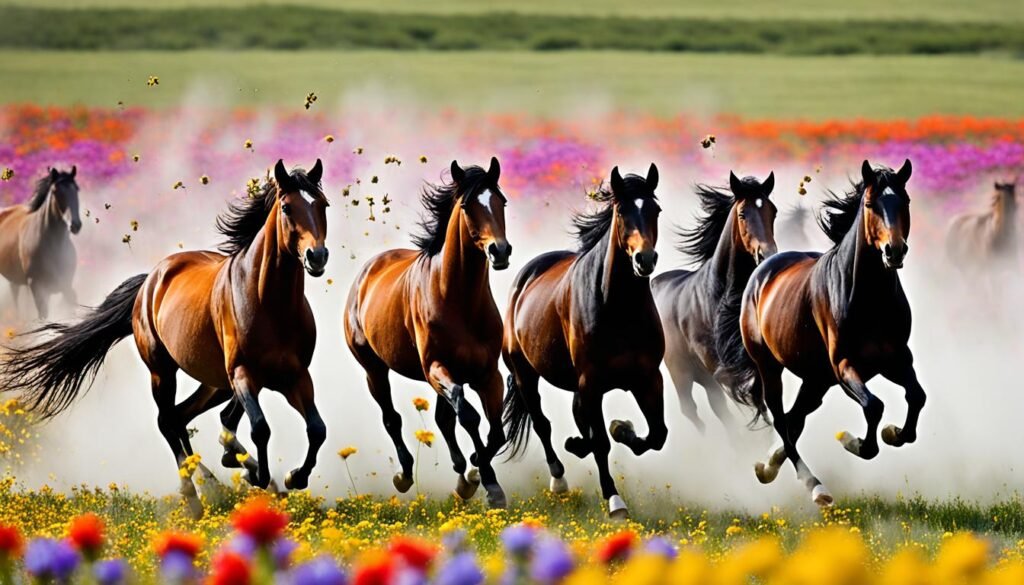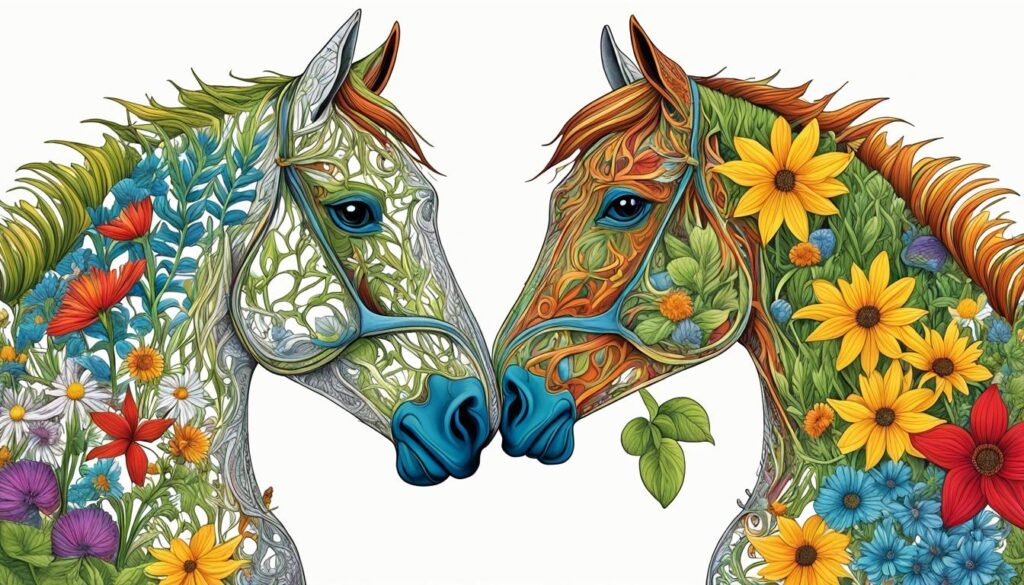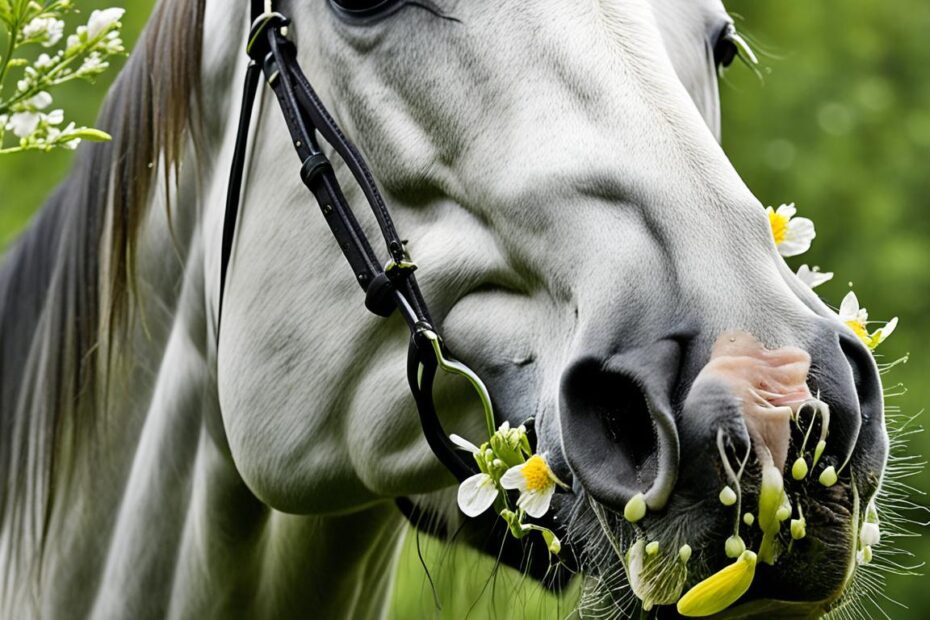In the captivating realm of nature, the intricate dance between horses and plants has long intrigued scientists and nature enthusiasts alike. Emerging research has shed light on a remarkable phenomenon: the role of equine saliva in the pollination process.
This article delves into the fascinating connection between the unique composition of horse saliva and its contribution to the intricate mechanisms of plant pollination.
Equine saliva, with its distinctive enzymatic profile, plays a crucial part in the delicate balance of mutualistic relationships between horses and the plants they encounter. By exploring the adaptations that allow equines to thrive as nectar-feeding pollinators, we unravel the mysteries behind the vital ecosystem services they provide.
From the dispersal of pollen to the maintenance of biodiversity, the impact of horse saliva on plant life is a testament to the remarkable interconnectedness of the natural world.
As we embark on this journey of discovery, we will examine the coevolutionary processes that have shaped these symbiotic relationships over time, and how the role of equines in sustaining healthy plant populations is crucial for the overall health of our ecosystems.
Join us as we delve into the secrets hidden within the saliva of these majestic creatures and their profound influence on the world of plant pollination.
Equine Saliva: A Remarkable Pollinator’s Ally
Equine saliva, the unsung hero of the pollination process, possesses a unique composition that plays a vital role in supporting the nectar-feeding adaptations of these remarkable animals.
Delving into the intricate world of equine saliva, we unveil a fascinating story of coevolutionary processes and mutualistic relationships between horses and the plants they interact with.
Exploring the Unique Composition of Horse Saliva
Horse saliva is a remarkable biological fluid, teeming with a diverse array of enzymes and compounds that facilitate the pollination process.
From amylases that break down complex carbohydrates to proteases that aid in the digestion of nectar-rich proteins, the composition of equine saliva is tailored to the specific needs of nectar-feeding equines.
Adaptations for Nectar-Feeding in Equines
Over the course of evolutionary time, equines have developed specialized adaptations to optimize their nectar-feeding abilities. These adaptations include a lengthened tongue, enhanced sensory perception, and the production of saliva with unique properties.
By harnessing the power of their saliva, equines can efficiently extract and consume nectar from a wide range of plant species, playing a crucial role in the pollination process.
| Equine Saliva Composition | Nectar-Feeding Adaptations in Equines |
|---|---|
| Amylases for carbohydrate breakdown Proteases for protein digestion Antibacterial and antifungal compounds Enzymes that facilitate nectar extraction | Elongated tongue for reaching deep into flowers Enhanced sensory perception to identify nectar-rich plants Specialized salivary glands that produce nectar-optimized saliva Ability to efficiently consume and transport nectar |
The interplay between the unique composition of equine saliva and the nectar-feeding adaptations of these animals has given rise to a mutually beneficial relationship, where horses play a crucial role in the pollination of a diverse array of plant species.
This coevolutionary process has not only shaped the physiology of both equines and plants but has also contributed to the maintenance of biodiversity within various ecosystems.
Plant Pollination Mechanisms: Unraveling the Mystery
The intricate dance of plant pollination is a captivating and complex process that has long intrigued botanists and ecologists alike. From the vibrant hues of flowers to the ingenious shapes of petals, plants have evolved a remarkable array of strategies to attract and engage their pollinators.
One of the key mechanisms employed by plants is the production of nectar, a sweet liquid that serves as a powerful lure for an array of pollinators, including bees, butterflies, and even hummingbirds.
The unique composition of this nectar, with its perfect balance of sugars and other nutrients, is tailored to the specific nutritional needs of the plant’s pollinator partners.
Beyond the allure of nectar, plants have also developed intricate physical adaptations to facilitate the transfer of pollen.
The shape and placement of their flowers, for instance, often align with the body structures and foraging patterns of their targeted pollinators, ensuring a seamless and efficient exchange of genetic material.
| Pollination Mechanism | Pollinator Adaptation | Ecosystem Service |
|---|---|---|
| Nectar production | Specialized mouthparts and feeding behaviors | Biodiversity maintenance |
| Flower shape and color | Visual cues and spatial recognition | Ecosystem stability |
| Pollen placement | Fur, feathers, or body structures | Crop pollination |
These intricate plant pollination mechanisms not only facilitate the successful reproduction of plants but also play a crucial role in maintaining the delicate balance of biodiversity within ecosystems.
By supporting the intricate web of interactions between plants and their pollinators, these mechanisms contribute to the overall health and resilience of natural environments, providing essential ecosystem services that benefit all life on Earth.
Investigating the Role of Horse Saliva in Plant Pollination
Equine saliva plays a fascinating role in the intricate process of plant pollination. At the heart of this relationship lie the salivary enzymes found in horses, which interact with pollen grains in a way that facilitates their dispersal and increases the chances of successful pollination. This synergistic interaction between horse saliva and pollen is a remarkable example of nature’s delicate balance.
Salivary Enzymes and Pollen Dispersal
The salivary enzymes present in horse saliva have a unique ability to break down the tough outer shell of pollen grains. This process, known as pollen digestion, helps to release the genetic material within the pollen, making it more susceptible to dispersal by wind, insects, and even the movements of the horses themselves.
As horses graze on nectar-rich plants, the pollen that clings to their fur and skin is then transferred to other plants, contributing to the pollination process.
Furthermore, the salivary enzymes in horse saliva can also act as a natural adhesive, helping to bind pollen grains together and increasing the chances of successful pollination. This symbiotic relationship between equine saliva and pollen dispersal is a testament to the intricate web of life that sustains plant communities.
| Salivary Enzyme | Function in Pollen Dispersal |
|---|---|
| Amylase | Breaks down the starch-based outer shell of pollen grains |
| Lipase | Disrupts the lipid-rich outer layer of pollen, facilitating release of genetic material |
| Protease | Digests the protein-based components of pollen, aiding in dispersal |
The intricate relationship between horse saliva and plant pollination is a captivating example of the interconnectedness of natural systems. By understanding the role of equine salivary enzymes in pollen dispersal, we gain valuable insights into the delicate balance that sustains our ecosystems.
Mutualistic Relationships: A Delicate Balance
The intricate relationship between horses and plants is a prime example of a mutualistic relationship, where both species benefit from the interaction.
This delicate balance has evolved over time through coevolutionary processes, shaping the adaptations of both horses and the plants they interact with.
Coevolutionary Processes and Biodiversity Maintenance
As horses have adapted to feed on the nectar and pollen of various plant species, the plants have in turn evolved to attract these pollinators. This coevolutionary dance has led to the development of specialized adaptations, such as the unique composition of horse saliva and the morphological features of certain plant species.
These adaptations have played a crucial role in maintaining the biodiversity of ecosystems, as the interdependence between horses and plants supports the thriving of a wide variety of plant and animal species.
The preservation of mutualistic relationships is essential for the continued provision of vital ecosystem services, such as food production, nutrient cycling, and the regulation of natural processes.
By understanding the complex interplay between horses and plants, we can gain insights into the delicate balance that underpins the health and resilience of our ecosystems.
| Mutualistic Relationship | Coevolutionary Processes | Biodiversity Maintenance | Ecosystem Services |
|---|---|---|---|
| Horses and plants benefit from their interactions | Adaptations have evolved over time to support the relationship | The interdependence between horses and plants supports a diverse range of species | The preservation of mutualistic relationships is crucial for vital ecosystem services |
By recognizing the significance of these mutualistic relationships, we can develop more effective conservation strategies and ensure the long-term sustainability of our natural environments.
Nectar-Feeding Adaptations: A Crucial Link
In the captivating world of plant pollination, the role of equine saliva takes on a remarkable significance. Horses, with their unique nectar-feeding adaptations, have evolved in tandem with the plants they interact with, forging intricate mutualistic relationships that are crucial to the maintenance of biodiversity.
One of the key adaptations that enable horses to efficiently extract and consume nectar is their specialized tongue. This flexible, prehensile organ allows them to delicately navigate the intricate floral structures, deftly collecting the precious nectar without damaging the delicate petals or stamens.
This precision-based feeding behavior, honed over the course of coevolutionary processes, ensures that the pollen is effectively transferred between flowers, facilitating the reproduction and dispersal of plant species.
| Adaptation | Benefit |
|---|---|
| Flexible, prehensile tongue | Enables precise nectar extraction without damaging floral structures |
| Specialized feeding behavior | Facilitates pollen transfer and plant reproduction |
| Evolved in tandem with plants | Supports the development of mutualistic relationships and biodiversity maintenance |
These remarkable nectar-feeding adaptations not only benefit the horses themselves but also play a crucial role in the overall health and resilience of the ecosystem.
By acting as efficient pollinators, horses contribute to the continued survival and diversification of plant species, ultimately enhancing the ecological balance and supporting the intricate web of life that underpins our natural world.
Ecosystem Services: The Pollination Powerhouse
Equines play a vital role in sustaining the delicate balance of our ecosystems through their unique contribution to plant pollination. This remarkable relationship between horses and the plant world is a testament to the intricate web of interdependence that underpins the natural world.
The Vital Role of Equines in Sustaining Ecosystems
The saliva of horses contains a remarkable array of enzymes and compounds that facilitate the pollination process. These equine adaptations have evolved over time, allowing them to effectively collect and transfer pollen from one plant to another.
This symbiotic relationship is essential for the maintenance of biodiversity, as it supports the reproduction and propagation of a vast array of plant species.
Equines, with their wide-ranging habitats and foraging behaviors, are uniquely positioned to serve as crucial pollinators in diverse ecosystems.
Their mobility and adaptability enable them to reach distant plant populations, ensuring the cross-pollination that is vital for the overall health and resilience of these natural systems.

By acting as living bridges between plant communities, equines contribute to the maintenance of complex food webs and the preservation of the delicate balance that sustains entire ecosystems.
This remarkable example of ecosystem services highlights the intrinsic value of these majestic animals and the urgent need to protect and conserve their habitats and populations.
Salivary Enzymes: Unlocking Nature’s Secrets
As researchers delve deeper into the intricate world of plant pollination, the role of horse saliva has emerged as a captivating area of study. Salivary enzymes, a unique component of equine saliva, have been found to play a vital part in the dispersal of pollen grains, ultimately aiding in the reproduction of various plant species.
These enzymes, such as amylase and lipase, possess the remarkable ability to interact with pollen, breaking down their protective outer layers and facilitating their release into the air. This process enhances the chances of successful pollen dispersal, increasing the likelihood of fertilization and the production of healthy plant offspring.
Recent scientific advancements have shed light on the complex mechanisms behind these equine-plant interactions. Researchers have discovered that the specific composition and properties of horse saliva have evolved in tandem with the needs of plant reproduction, creating a mutually beneficial relationship that has stood the test of time.
Unlocking the Secrets of Salivary Enzymes
By studying the intricate interplay between salivary enzymes and pollen grains, scientists have gained invaluable insights into the delicate balance of nature.
These findings not only deepen our understanding of plant reproduction but also highlight the crucial role that horses, as a keystone species, play in maintaining the health and diversity of ecosystems.
| Salivary Enzyme | Function in Pollen Dispersal |
|---|---|
| Amylase | Breaks down the starch-based outer layer of pollen grains, facilitating their release and dispersal. |
| Lipase | Disrupts the lipid-rich coating of pollen, enhancing their ability to become airborne and reach plant stigmas. |
| Protease | Degrades the protective proteins surrounding pollen, further aiding in their dispersal and successful pollination. |
As we continue to unravel the secrets of salivary enzymes and their role in plant reproduction, we gain a deeper appreciation for the intricate web of life that sustains our natural world.
By understanding these remarkable adaptations, we can work towards preserving the delicate balance of ecosystems and ensuring the long-term viability of our planet’s flora and fauna.
Pollen Dispersal: A Journey of Renewal
Pollen dispersal is a crucial aspect of plant reproduction, and equine saliva plays a remarkable role in this intricate process.
Horses, with their unique adaptations for nectar-feeding, have evolved a remarkable partnership with the plant kingdom, contributing to the successful dissemination of pollen grains.
Equine Saliva and Plant Reproduction
The composition of horse saliva is remarkably suited to facilitate pollen dispersal. Salivary enzymes present in equine saliva have been found to interact with pollen grains, enhancing their viability and promoting their dispersal.
This symbiotic relationship between horses and plants is a testament to the intricate web of life that sustains our ecosystems.
As horses feed on nectar-rich plants, their saliva comes into contact with pollen, effectively capturing and transporting these vital reproductive units to new locations. This process not only ensures the successful pollination of plants but also contributes to the maintenance of plant diversity and the overall health of ecosystems.
The role of equine saliva in pollen dispersal is a remarkable example of the interconnectedness of nature. By understanding and preserving these delicate relationships, we can gain valuable insights into the mechanisms that sustain the delicate balance of our natural world.
Coevolutionary Processes: A Fascinating Interplay
The intricate relationship between horses and the plants they interact with has been shaped by a captivating process known as coevolution.
This reciprocal adaptation, where both species evolve in response to each other, has led to the development of remarkable mutualistic relationships that are essential for the maintenance of biodiversity.
Over time, horses and the plants they frequent have undergone a remarkable dance of evolution, each species adapting to better suit the needs of the other. As horses have evolved specialized adaptations for nectar-feeding, the plants they visit have, in turn, evolved unique floral structures and chemical compositions to attract these equine pollinators.
This coevolutionary process has not only strengthened the bonds between horses and plants but has also played a crucial role in shaping the diverse ecosystems in which they thrive.
By facilitating the dispersal of pollen, horses have become integral to the reproductive success of countless plant species, contributing to the vibrant tapestry of life that characterizes their shared habitats.
Understanding the intricate interplay between horses and plants, and the coevolutionary processes that have shaped their relationship, is key to unveiling the secrets of nature’s delicate balance.
This knowledge can inform conservation efforts, guiding us towards a future where these mutualistic relationships continue to flourish, and the biodiversity they support remains a testament to the wonders of the natural world.

| Coevolutionary Processes | Mutualistic Relationships | Biodiversity Maintenance |
|---|---|---|
| Reciprocal adaptations between horses and plants | Symbiotic interactions that benefit both species | Vital role in sustaining diverse ecosystems |
| Evolution of specialized traits and behaviors | Equines as key pollinators for plant reproduction | Preserving the delicate balance of nature |
| Strengthening the bonds between horses and plants | Facilitating the dispersal of pollen | Informing conservation efforts |
Conclusion: Embracing Nature’s Wonders
As we reach the culmination of our journey through the captivating realm of horse saliva and its role in plant pollination, it becomes evident that these seemingly disparate elements are intricately woven together, forming a tapestry of remarkable ecological interdependence.
The horse, once seen as a mere beast of burden, emerges as a pivotal player in the delicate dance of plant reproduction, its saliva serving as a silent but powerful ally in the maintenance of biodiversity and the provision of essential ecosystem services.
The research presented in this article has shed light on the unique adaptations of equines, their salivary enzymes, and the coevolutionary processes that have forged the intricate relationship between these majestic creatures and the plants they encounter.
By understanding the intricate mechanisms at play, we gain a deeper appreciation for the resilience and adaptability of nature, as well as our own responsibility to protect and preserve these intricate systems.
Indeed, the humble act of a horse feeding on nectar has far-reaching implications, from the dispersal of pollen to the sustenance of entire ecosystems.
As we embrace the wonders of this natural phenomenon, we are reminded of the profound interconnectedness that exists within our world, a tapestry of life that is at once fragile and resilient, demanding our vigilance and our reverence.
Let us, then, move forward with a renewed sense of wonder and a commitment to safeguarding the delicate balance that allows horse saliva and plant pollination to thrive, for the benefit of generations to come.
FAQ
What is the unique composition of horse saliva?
Horse saliva has a remarkable composition that includes various enzymes and compounds that play a crucial role in the plant pollination process. These salivary components have evolved to support the nectar-feeding adaptations of equines.
How do equine nectar-feeding adaptations contribute to plant pollination?
The unique physical and behavioral characteristics of horses, such as their tongue and feeding behaviors, have evolved to efficiently extract and consume nectar from flowers. These adaptations have led to the development of mutualistic relationships and coevolutionary processes between horses and the plants they interact with.
What are the mechanisms involved in plant pollination?
Plants employ various strategies to attract pollinators, such as the production of nectar and the unique shapes and colors of flowers. These pollination mechanisms contribute to the maintenance of biodiversity and the provision of vital ecosystem services.
How do the salivary enzymes in horse saliva facilitate pollen dispersal?
The specific salivary enzymes found in horse saliva interact with pollen grains, facilitating their dispersal and increasing the chances of successful pollination. These interactions between equine saliva and pollen contribute to the overall health and reproduction of plant communities.
What is the role of mutualistic relationships in the coevolutionary processes between horses and plants?
The delicate balance of mutualistic relationships between horses and plants has been shaped by coevolutionary processes over time. These adaptations benefit both species and are crucial for sustaining biodiversity and providing essential ecosystem services.
How do the nectar-feeding adaptations of equines contribute to their role as pollinators?
The nectar-feeding adaptations of horses, such as their tongue and feeding behaviors, have evolved to efficiently extract and consume nectar from flowers.
These adaptations have led to the development of mutualistic relationships and coevolutionary processes between equines and the plants they interact with, making them important pollinators.
What are the ecosystem services provided by equines through their role in plant pollination?
Equines play a vital role in sustaining ecosystems through their contribution to plant pollination. Their interactions with plants contribute to the maintenance of biodiversity and the overall health of natural systems, providing essential ecosystem services.
How do the salivary enzymes in horse saliva impact plant reproduction?
The salivary enzymes found in horse saliva interact with pollen grains, facilitating their dispersal and increasing the chances of successful plant reproduction. These intricate mechanisms play a crucial role in maintaining healthy plant populations and contributing to the overall biodiversity of ecosystems.
What are the coevolutionary processes that have shaped the relationships between horses and plants?
The fascinating coevolutionary processes have led to the development of mutualistic relationships between horses and the plants they interact with. These reciprocal adaptations have evolved over time, and they continue to influence the dynamics of natural ecosystems, contributing to the maintenance of biodiversity.

